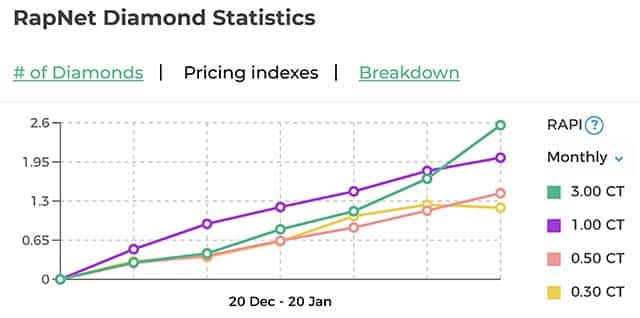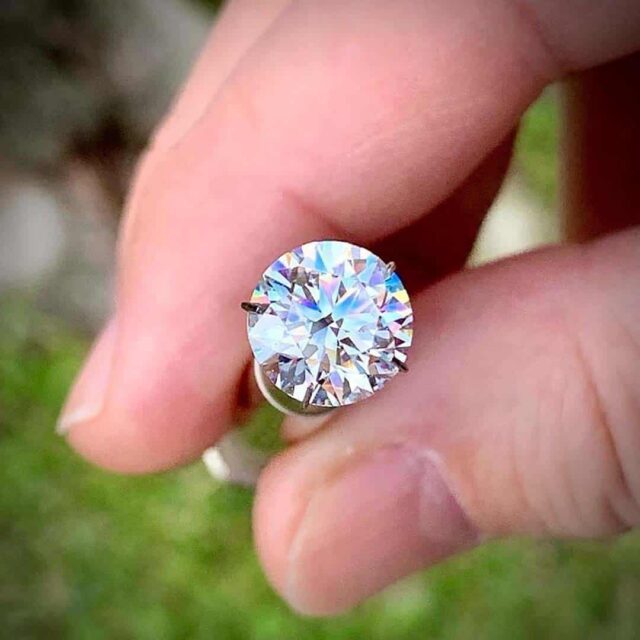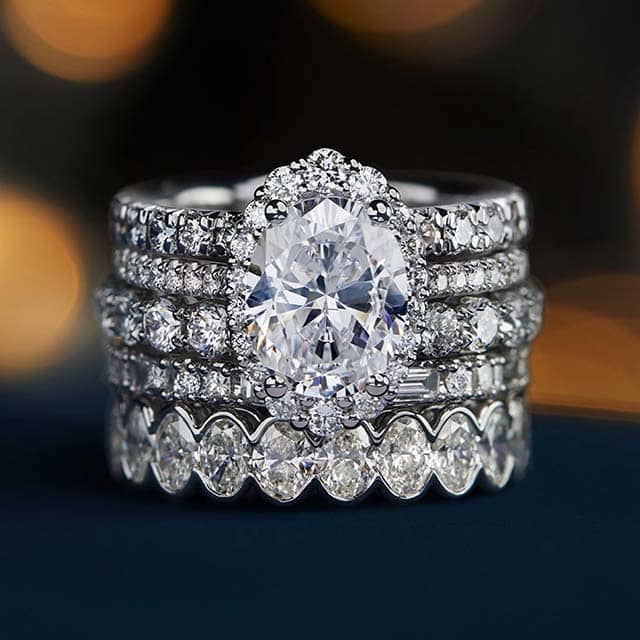The infamous De Beers' slogan "A Diamond Is Forever" first made its debut in 1947. The slogan was coined by Frances Gerety of NW Ayer in 1947.
Consequently, the campaign became an overnight success and is still well-known today. Of course, at that time, the diamond industry followed a traditional method of distribution similar to this:
- 1De Beers was a monopoly.
- 2De Beers sold rough crystal to diamond cutters.
- 3The diamond cutters sold polished diamonds to wholesalers.
- 4Diamond wholesalers sold to retail jewelry stores.
- 5The retail jewelry stores sold fine jewelry to the public.
There are many factors which have contributed to the demise of the tiers of distribution within the diamond industry. However, the most popular approach is to blame falling diamond prices on the following internet diamond dealers:
A Diamond Is Forever But The Market Is Evolving:
For the record, we were one of the first companies to sell diamonds online. Nice Ice Diamonds first became available online back in 1996. It's difficult to imagine the uproar we caused by selling internet diamonds during the era of dial-up modems.
Shortly after launching the site, I attended the JCK Diamond & Jewelry Trade Show in Las Vegas, Nevada. While standing in line for a cup coffee at Starbucks, I struck up a conversation with another attendee.
The conversation was going great, right up until the point where he spotted my ID badge. Then, there it was staring him right in the face: Todd Gray, Diamond Buyer for niceice.com
Based on the look on his face, it was clear that he'd come face-to-face with Saddam Hussein or Satan himself. After taking a moment to consider what may have been the consequences for aggravated assault or possibly even murder, the guy begins spouting off a bunch of nonsensical nonsense about falling diamond prices being my fault.
I openly admit that what follows next is not going to be popular with most retail jewelers. However, the idea that diamond prices are falling is nonsensical bullshit. My career in the diamond business began in October 1986. At that time, a 1-carat, G-color, VS-2 clarity, round brilliant cut diamond was selling for around one thousand dollars.
Fast Forward To The Present:

Diamond Price Index, January 2022.
This 1.046 carat, G-color, VS-2 clarity, Black by Brian Gavin diamond is about ten grand. Consequently, the basic characteristics are comparable, but there are distinct improvements in sparkle factor.
Nevertheless, the price of diamonds increased tenfold during the course of my career. So, pull your head out of the sand, Chicken Little. Stop clucking on about falling diamond prices because they're obviously going up.
This 1.046 carat, G-color, VS-2 clarity, Black by Brian Gavin diamond is about ten grand. Consequently, the basic characteristics are comparable, but there are distinct improvements in sparkle factor.
What Goes Up Doesn't Necessarily Go Down:
Consequently, the price of diamonds has increased tenfold throughout the course of my career. So, pull your head out of the sand, Chicken Little, and stop clucking on about falling diamond prices.
Rather, take a look at the surface of the sand that is constantly shifting under the weight of the De Beers Diamond Trading Company (DTC). Perhaps, then you'll see, that what is actually falling are your profit margins.
Gone are the mythical days of double to three time margins and mark-ups. The modern internet diamond dealer survives on thin margins because they compete globally, not locally.
Of course, you may continue to paint us as one of the internet diamond dealers that caused the infamous collapse. However, but the truth is that I envisioned the ice age coming a long time ago. That's why we continually migrate our business model and adapt to the modern age of diamonds.
The Nice Ice Age of Diamonds:
I hate to say that I told you so, but it's not like you didn't have advance notice that times were changing. We originally published this article during the year of our overlord, 2013 A.D.
Inasmuch as some things change, there are many others that never will. For example, there was lots of speculation about the effects the internet would have upon your retail existence as far back as 1997.
In fact, that's when 50 members of the trade organization Polygon sued us for “disclosure of proprietary information to the public” and “disparagement of an entire industry.”
Whatever that means. The “entire industry” ~ really?!?! I never imagined that we were that influential. I’m truly flattered. Would you like me to autograph your JCK badge?
Consequently, that slap-suit was filed shortly after a major trade publication featured a headline on the front cover of their magazine that read something like “Due to the emergence of diamond dealers on the internet, the retail jeweler will be extinct by the year 2000”.
Prices Change But A Diamond Is Forever:
Consequently, the trade journal that predicted the demise of retail jewelry stores is now extinct. It's unclear whether suggesting that internet diamond dealers were killing the industry by “prostituting diamonds via the internet” was a key factor.
However, that statement did make me pretty popular at the JCK Trade Show. In contrast, only a few people appreciated the irony of the Public Enemy #1 custom diamond pendant that I wore to the show.
That's right, I still dared to show my face despite the rumors that there was a bounty on my head. I was pretty certain that the threat of being boiled in snot were little more than bravado.
Thankfully Blue Nile entered the scene in 1999 and gave you something else to worry about. We walked the show around the show proudly showing off the bright Red A‘s that you painted upon our chests.
The Evolution of Internet Diamonds:
Of course, we weren't only selling diamonds online, we also operated a brick and mortar jewelry store. Consequently, our online diamond prices are in-store prices were the same. In that case, we weren't doing anything that our retail peers could not do.
We simply chose to operate from a different perspective and embrace the power of the internet. That transition positioned us as a low price leader for high-quality merchandise.
As a result, we sold more diamonds in a month than most Mom and Pop jewelry stores sell in a year. Of course, our per-stone profits were considerably lower than traditional retail mark-ups provide.
Beware Stories of Falling Prices:
The fact that some retail jewelers believe that “diamond prices are falling” is evidence that they are out of touch. First, with the the state of the global economy, and also the value of the U.S. Dollar.
Diamond prices are not dropping any more than the price of gold or gasoline. Arguably, diamond prices are not really going up either. That's because everything is in relationship to the dollar and this little thing called inflation.
Under those conditions, the internet has little effect upon diamond prices. However, the internet does make it possible to buy diamonds online. It has also changed how we market other types of goods and services.
In that case, you can keep glaring at me with those glowing red eyes, Chicken Little. But, first, let me share a simple lesson in distribution that I think you’ll benefit from reading.
Traditional Channels of Distribution vs. the Internet.
It seems like most retail jewelers are incapable of calmly discussing the state of the diamond industry. In that case, I'm going to try a slightly different tactic.
Imagine that the only discernible difference between a Ferrari and a Lamborghini is the name and symbol that identifies the manufacturer.
Let's also say that both companies produce a car that looks the same. They also share the exact same characteristics and specifications. In fact, there isn’t even a difference in color or interior. The two cars look identical in a side-by-side comparison and there is no difference in performance.
What will happen if the Board of Directors for Ferrari or Lamborghini wake up tomorrow and change how they distribute their product? Of course, they're not going to change the overall quality, nor their profit structure.
They're simply going to reorganize the channels of distribution from the Manufacturer to a Wholesaler to an Authorized Dealer who sells to Consumers.
To a more modern method of distribution that moves the product from the Manufacturer to an Authorized Dealer and then to Consumers.
Or perhaps an even more ultra modern method of distribution that cuts out the middlemen between Manufacturers and Consumers.
Would there be a measurable difference in the price which consumers pay for their car if they purchased it via one method or the other? I'll assume that you're smart enough to say "Yes".
Watch Me Pull a Rabbit Out of a Hat:

Black by Brian Gavin Diamonds Are Forever.
Hypothetically speaking, if there was a measurable difference in price, are people likely to purchase from one company or another based on a difference in the presentation and marketing?
For clarification purposes, we're still talking about diamonds with the same characteristics. We're not talking about the difference between Carats and Karats.
As that may be, then the correct answer is still yes. In fact, it's also likely that their customers might adamantly defend their decision to purchase from one company over another.
For example, they might say argue that Black by Brian Gavin diamonds sparkle more than other brands. There are many reasons why this is true. First, they are cut to a precise range of proportions and exhibit a higher degree of optical precision.
In addition, Brian Gavin holds the patent for maximizing light performance in the modern round brilliant cut diamond. In that case, they incorporate a proprietary diamond polishing process not available elsewhere. The benefit with a two carat diamond, for example, is that it creates more virtual facets which produce a more vivid and intense sparkle factor.
That creates more virtual facets within the diamond and that produces sparkle that is more vivid and intense.
Consequently, somebody else might argue that De Beers Forevermark diamonds are better. And the truth is that might be true from their perspective depending on their model of the world.
However, the Advanced ASET Scope images that Brian Gavin provides are hard to beat. Consequently, Brian Gavin used to produce hearts and arrows diamonds for our private label collection. In that event, he's one of the manufacturers who is now selling their production direct to the public.
Natural Diamonds Are Forever, But What About Lab-Grown?
From a historical perspective, it appears that the De Beers A Diamond Is Forever slogan is right on the money. However, there have been significant changes in how diamonds are distributed.
There are have also been substantial improvements in diamond cut quality and manufacturing processes. Not the least of which is the technology that makes it possible to grow lab-grown diamonds.
Under those circumstances, I predict that we'll continue to see the traditional tiers of distribution collapse. There might always be Forty Seven Levels of Diamonds Wholesale parlayed along 47th Avenue in New York. Meanwhile, they'll attempt to conduct business as usual in the World Diamond Centers.
However, the source of the power that drives diamond sales worldwide will most likely be the internet. Not only because it provides people with volumes of free diamond buying advice. But, also, because it's practically impossible for traditional retail to compete with the sheer volume.
As of today, there are more than 600,000 diamonds to choose from on Blue Nile. Simultaneously, there are approximately 374,000 different diamonds available from James Allen. Consequently, the latter vendor does sell lab-grown diamond engagement rings while the 800-pound Gorilla in the Room does not.
The End of a Millenia?
Suffice to say that retail jewelry stores, nor the world came to an end on Y2K. In fact, the diamond market and the world continue to go strong despite the challenges that COVID presents.
In that case, it's essential for traditional brick and mortar stores to align with the not-so-new breed of customers online. Consequently, that might require some retail jewelry store owners to use their smartphones for more than Facebook and Instagram.
For instance, they might need to analyze online diamond prices and sharpen their pencil to a finer point. Perhaps, they'll also brush up on the fine points of diamond cut quality and light performance.
Oh, who am I kidding? We all know that it's easier for them to bury their heads in the sand and blame somebody else. "Woe Is me. Woe Is Me. A Diamond Is Forever, but the internet killed my profits."
Clearly, the choice is yours, but I'm confident that you'll choose incorrectly. It practically goes without saying that history repeats itself.
In that case, my dear friend Chicken Little, the Sky is Falling. But, did you even bother to buy the domain name? Consequently, I just checked and the dot com is taken, but it's not owned by a retail jeweler.

